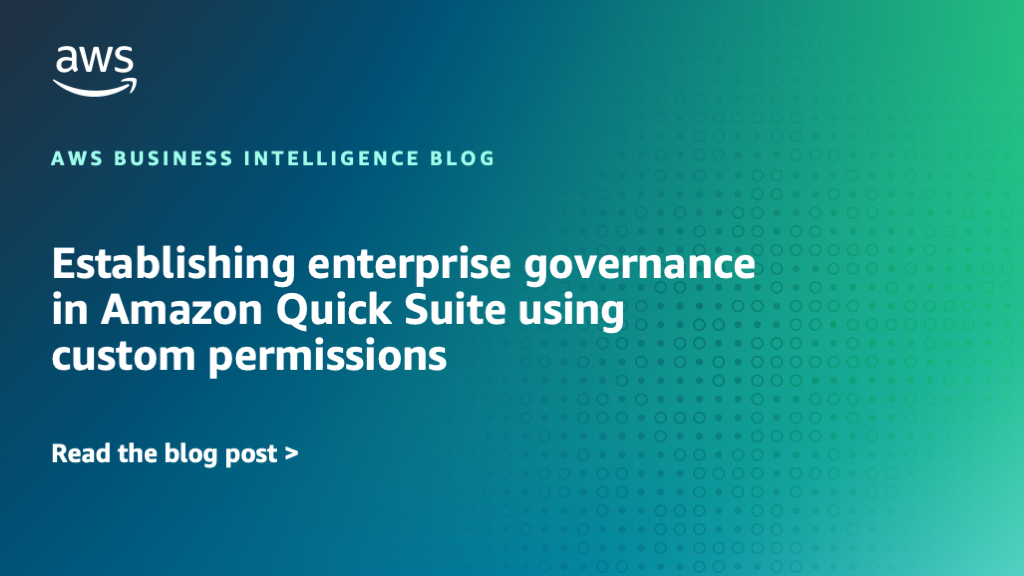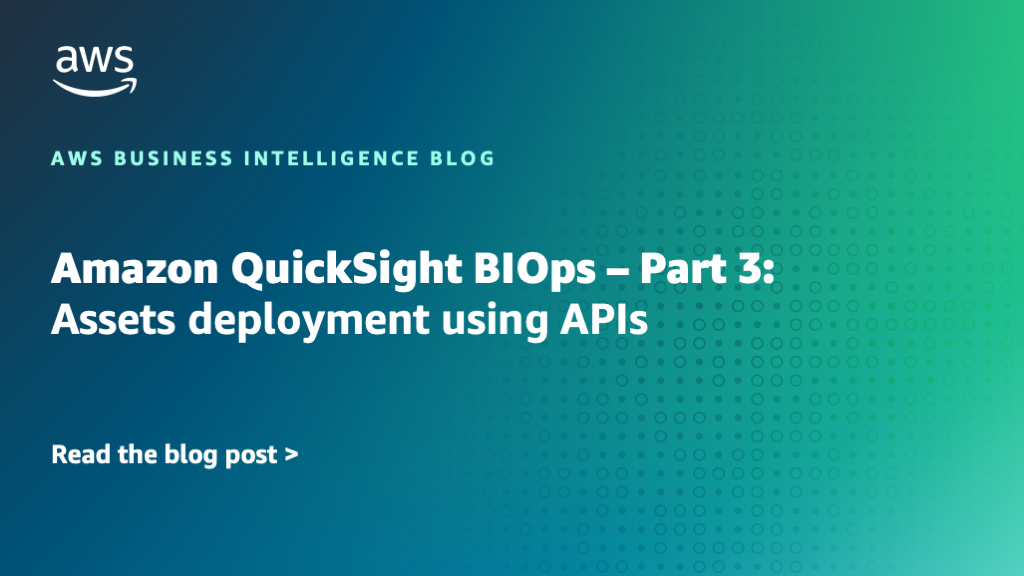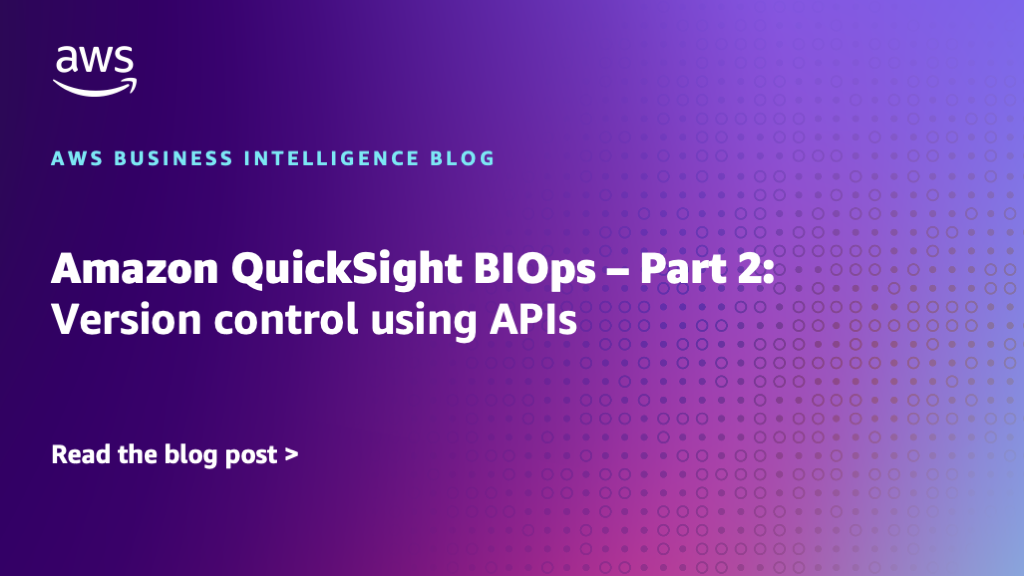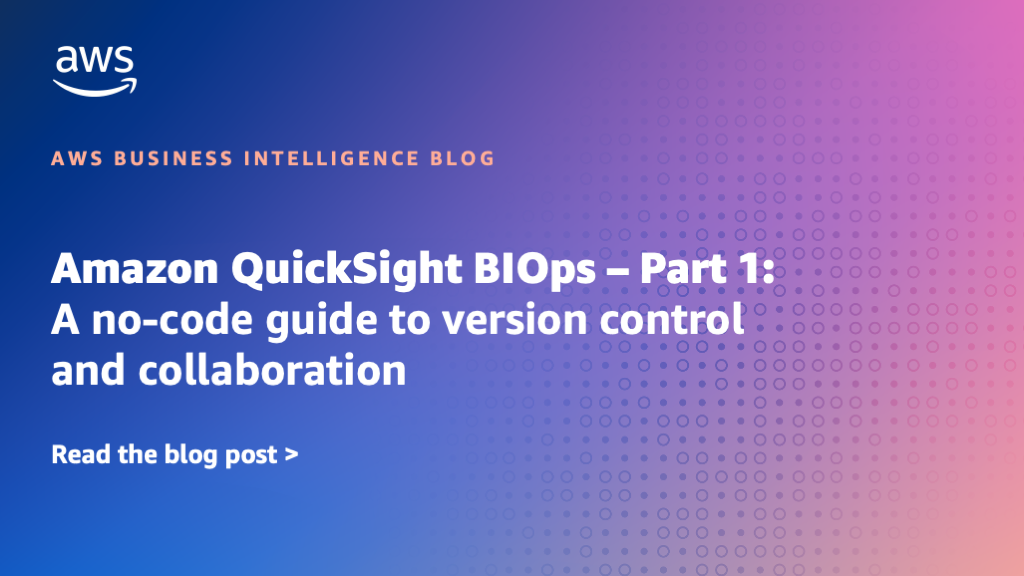AWS Business Intelligence Blog
Category: Best Practices
Establishing enterprise governance in Amazon Quick Suite using custom permissions
In this post, we explore how Amazon Quick Suite administrators can implement comprehensive enterprise governance using custom permissions at account, role, and user levels. The post provides a detailed guide on restricting various capabilities like Flows, Automate, Spaces, Actions, Chat Agents, Research, Analyses, and Dashboards while maintaining security and user access policies.
Amazon QuickSight BIOps – Part 3: Assets deployment using APIs
In part 3 of this post series, we explore API-driven BIOps strategies in QuickSight, focusing on cross-account and multi-environment asset deployment, conflict detection and resolution during dataset updates, and permission management across different environments.
Amazon QuickSight BIOps – Part 2: Version control using APIs
In part 2 of this post series, we explore how to implement API-driven business intelligence operations (BIOps) framework in Amazon QuickSight to reduce manual workload and improve lifecycle management.
Amazon QuickSight BIOps – Part 1: A no-code guide to version control and collaboration
In part 1 of this post series, we demonstrate how to implement BIOps using the no-code console features of Amazon QuickSight, showing how to version dashboards, reuse visuals, collaborate in parallel, and safely deploy updates through the QuickSight UI.
Optimize your Amazon QuickSight implementation: a guide to usage analytics and cost management
We’ve heard from customers that analyzing user activity and understanding usage patterns has been challenging. Common questions include “How many Reader Pro licenses have we added in the last 90 days?” and “What’s our actual session consumption pattern?” To address these needs, we’re excited to share a solution that makes it easier than ever to gain insights into your QuickSight usage and make data-driven decisions about your BI implementation.
Support multi-tenant applications for SaaS environments using Amazon QuickSight
This post provides guidance on deploying QuickSight in a multi-tenant environment, and the considerations around data isolation and deploying resources to tenants in a QuickSight application. Multi-tenancy within applications provides a mechanism to segment groups of users from one another. These groups could be users from different companies, different geographic regions, or different lines of business within an enterprise. Users within different tenants can’t see other users, data, and assets, while reducing the complexity of having a different infrastructure for each set of users.
Announcing QuickSight Arena: Explore Amazon QuickSight for free and showcase your dashboards
The Amazon QuickSight Community serves as a one-stop-shop where business intelligence (BI) authors and developers from across the globe can access learning content, ask and answer questions, stay up to date, network, and learn together about Amazon QuickSight. QuickSight powers data-driven organizations with unified BI at hyperscale. With QuickSight, all users can meet varying analytic needs from the same source of truth through modern interactive dashboards, paginated reports, embedded analytics, and natural language queries. In this post, we walk through the new QuickSight Arena—an embedded instance of QuickSight on the QuickSight Community—and explain its use cases and how to get started.
AWS recognized as a Strong Performer in The Forrester Wave: Augmented Business Intelligence Platforms, Q2 2023
AWS has been named a Strong Performer in the Forrester Wave’s 27-criterion evaluation of augmented business intelligence (BI) platforms providers for Q2 2023. Forrester evaluated 14 providers for their core BI features, ease of integration with machine learning, conversational UI, ease of use, and flexibility. Amazon QuickSight emerging as a Strong Performer validates for us […]
Unlock the power of unified business intelligence with Google Cloud BigQuery and Amazon QuickSight
Amazon QuickSight is a cloud-native, serverless business intelligence (BI) service that lets you build visualizations, perform ad hoc analysis, and gain insights through machine learning (ML) capabilities such as anomaly detection, forecasting, and natural language querying. QuickSight utilizes its robust in-memory engine SPICE (Super-fast, Parallel, In-memory Calculation Engine) to rapidly perform advanced calculations and deliver visuals.BigQuery is Google Cloud’s fully managed, petabyte-scale, cost-effective analytics data warehouse that lets you run analytics over vast amounts of data in near-real time. In this post, we walk you through the permissions and connection details needed in BigQuery to bring BigQuery data into QuickSight through OAuth and create a simple dashboard.
New enhancements in Amazon QuickSight: Programmatic export to Excel format
Amazon QuickSight is a scalable, serverless, embeddable, machine learning (ML)-powered business intelligence (BI) service built for the cloud. You can now export content to Excel workbooks by selecting multiple tables and pivot table visuals from any sheet of a dashboard on the QuickSight console via schedules or programmatically via a set of new Snapshot Export APIs. This post outlines these new functionalities and guides you through their implementation.









